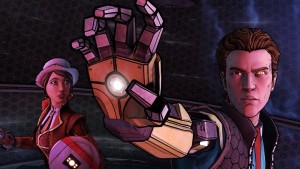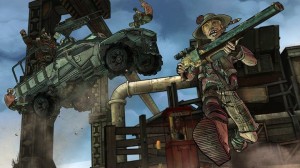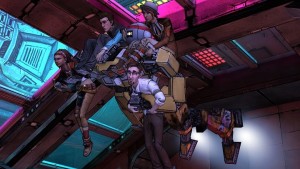Liverpool Sound and Vision Rating 9.5 out of 10
Tales from the Borderlands is a third-person episodic adventure game available for download from the PlayStation Store for the PS4 and PS3. The first Borderlands game was released in 2009 and went onto become a smash hit.
The game spawned sequels including Borderlands 2 and Borderlands: The Pre-Sequel and spin-offs such as Borderlands Legends and Borderlands Online. Borderlands has entered other media beyond videogames including multiple comic book series which have fleshed out the story elements such as the four issue release of Borderlands: Origins which told the back story of how the four main protagonists of Borderlands came together and the eight issue release of Borderlands: Fall of Fyrestone followed the events of the first game. Multiple novels have told stories particularly situated after the first game, a variety of soundtrack albums have been released containing music from the games and downloadable content campaigns and even a film adaptation of the Borderlands series is in development at Lionsgate who are responsible for such successful blockbuster film series as Divergent, The Hunger Games and The Expendables.
The partnership of Gearbox Software who created the Borderlands series and Telltale Games was sparked at the 2012 Spike TV VGAs on a night when Gearbox Software’s Borderlands 2 and Telltale Games’ The Walking Dead was successfully winning more awards than any other game or developer. A meeting took place that very night with ideas pitched resulting in the original hybrid first-person shooter role-playing game having received mass critical acclaim the world over and over 26 million sales combining with one of the best storytellers in the entire videogame industry for a much anticipated videogame collaboration.
The story is set on Pandora after the events of Borderlands 2 as a Hyperion business man named Rhys is wrongfully demoted with his promotion prospects in tatters. Rhys sets about returning the favour to his new boss Hugo Vasquez by pulling off a major plan that he knows will unquestionably gain his revenge by stealing the super rare and incredibly valuable Vault Key from Pandora which Vasquez desperately wants to purchase for $10,000,000, although not everything goes according to plan with a gradual set of hurdles for Rhys and his allies to overcome.
There are a number of gameplay mechanics such as Rhys’ Echo Eye implant which allows him to scan objects to obtain information about them as recorded in the Hyperion database, while he also has a mechanical right arm which he bought to help him in his dedication to his former job of data-mining. Considering Fiona is a con artist for the purpose of making money, therefore she is able to steal money in the same style as looting throughout the Borderlands series, Loader Bot is a personally customised Hyperion Loader designed to help and protect Rhys on Pandora and which are all excellent design choices bringing fun and unique elements to the core gameplay mechanics.
Rhys and Fiona are both superb lead characters as they are charming in how they deliver their humorous and sarcastic dialogue with Rhys being part of Hyperion and Fiona being a Pandoran con-artist looking to make the next big score, while they have great chemistry with their allies such as Rhys’ accountant Vaughan, Fiona’s sister and partner in crime Sasha, Loader Bot which looks reminiscent of what would be anticipated from a Transformers film, an appearance from series favourite Claptrap later into the game and more besides, complimented further by rather crazy characters such as Shade. However, despite the chemistry between characters, there is danger around every corner as enemies include a variety of insane bandits and skags returning from the Borderlands series as well as new villains such as August and Hugo Vasquez.
The environment design is clearly inspired by the Borderlands series including everything from wastelands spread throughout a variety of areas to a coliseum style race track stadium, Scooter’s Catch a Ride garages and research facilities.
The extras include unlocks which consists of bonus content such as exclusive weapons, heads and skins for use in Borderlands: The Pre-Sequel for anyone who owns the season pass and a My Choices feature which is gradually unlocked as players progress through the game as well as five sets of credits to thank everyone who worked on creating each episode.
The My Choices feature is quite reminiscent to the feature found in Telltale’s previous games such as both seasons of The Walking Dead and The Wolf Among Us episodic games by providing an entire listing choice including the statistical analysis regarding the percentage of players who have made the same choice as the player for each moral decision as well as a variety of decisions that are scattered throughout the chapters of each episode such as telling Loader Bot to evacuate, placing trust in Sasha or choosing to have respect and loyalty for the accountant Vaughan over a deal and with the feature being directly available from the main menu and at the end of each episode.
Until a Vita version is potentially released, remote play of the PS4 version on Vita is a consolation with the performance during remote play is on par with the graphics, audio and general performance of the PS4 version, while the control scheme has been appropriately optimised resulting in a comfortable control scheme as fighting actions has moved from R2 to R when prompted, displaying the inventory has also been mapped from R1 to R when not prompted for fighting actions, showing selectables has moved from L2 to L and Echo Eye has been mapped from L1 to L, while the rest of the controls remain exactly the same as the PS4 version, therefore resulting in a remote play experience that will keep players satisfied until a Vita version is hopefully released.
The controls are well mapped to the DualShock 4 controller with the refinements found in the control scheme from the second season of The Walking Dead and The Wolf Among Us being retained in regards to providing a greater differentiation between actions, conversations and fighting. The control scheme consists of pressing X, triangle, square or O to perform actions, start a conversation or to choose a response in a conversation with the buttons being clearly marked towards the bottom of the screen. Pressing R2 to perform fight actions when defending in a one-on-one encounter with a bandit, pressing L2 to show selectables, pressing R1 to display inventory, pressing L1 to utilise Echo Eye or money, mashing certain face buttons such as X, triangle, square or O when attempting to open a vent, shut a door or freeing Rhys or Fiona from a bandit as the buttons are randomly generated each time the player starts. Changing the direction of the left analogue stick to move the character as he walks around to explore the environment, changing the direction of the right analogue stick to move the cursor around the environment for the player to investigate and observe certain objects and items of importance as well as deciding who to start or continue a conversation with or even positioning aim when the player is about to defend themselves and avoiding attacks or gunfire from enemies, pressing the share button takes the player to the share feature menu and pressing the options button to display the pause menu.
There is no touch pad implementation which is surprising as the quick time events (QTEs) could have been optionally mapped to the touch pad or it could have otherwise been utilised as an optional method of exploring the surrounding environments or even participating in conversations and moral choices, while the light bar could have produced green gradually fading to red as the time available to perform a QTE during a one-on-one encounter with a bandit ticks down, alongside the lack of DualShock 4 vibration which could have been utilised when Rhys or Fiona gets into one of their many fights with bandits or when they have had a heavy fall during their exhaustive exploration.
Graphically, Tales from the Borderlands is excellent as the animations of the character models are fluent, while the game possesses a visually striking Borderlands inspired cel shaded art style that looks even better than previous Telltale games such as The Walking Dead: Seasons 1 and 2 and The Wolf Among Us with the characters and environments living up to the quality associated with the Borderlands series.
The presentation of the game is solid with a great user interface across various menus such as the main, episodes, extras, my choices, settings and gameplay menus with support for navigation via the left analogue stick, directional pad and face buttons, although it does not include support for navigation via the right analogue stick and touch pad. The background of the menus focuses upon two of the lead characters as they stand back to back checking their gadgets and looking at what is around them as the camera pans around both characters showing a variety of environments in day and night.
The entire voice-over cast provides exceptional performances which bring their characters to life with humour, charm and diversity with all new characters including Troy Baker starring as one of the two lead characters Rhys as well as Tommy. Laura Bailey voices Fiona, Nolan North as August, Erin Yvette Ashe voices Sasha, Chris Hardwick as Vaughn, Patrick Warburton voices Hugo Vasquez, Dave Fennoy as Finch and Ashley Johnson voices Gortys. There are returning characters from Borderlands games such as Dameon Clarke voicing Handsome Jack, Brina Palencia as Mad Moxxi, Bruce DuBose voices Marcus Kincaid, Raison Varner as Loader Bot, Brad Jackson voicing Shade, Michael Turner as Vault Hunter Zer0, Michael Neumann voices Scooter, Jason Liebrecht as Mordecai, Marcus Mauldin voices Brick and David Eddings as Claptrap.
The sound effects include walking, interaction with objects and ambience relevant to certain areas such as an audience in a stadium during a race in the first episode, while the music introduces the tone of a futuristic western. The lack of any DualShock 4 speaker implementation is surprising as it could have produced a further layer of audio with voice-overs for conversations, sound effects such as ambience or a sound when collecting money or music.
The trophy list includes 36 trophies with 20 bronze, 10 silver, 5 gold and 1 platinum trophy. The trophy list for all 5 episodes of Tales from the Borderlands is entirely based upon completing each chapter within each episode; resulting in a somewhat easy trophy list in regards to the fact that players will platinum the trophy list if they are able to complete the story with only a single playthrough required. It is estimated that depending upon skill and a good trophy guide to provide some helpful tips that it would take between 10 to 15 hours to platinum the trophy list.
The difficulty curve certainly fluctuates throughout the game as there are some tough one-on-one encounters with bandits, whilst players are naturally required to explore their surroundings, alongside other parts of the game that will require the player to have conversations with characters to progress on towards the goals. When in one-on-one encounters with bandits players will be required to do some button mashing, but these encounters are made harder by the buttons being randomly generated each time play commences. This approach means that it no longer becomes anything related to memorising a certain button sequence and instead it becomes more about fast reflexes to ensure that the player survives against such a dangerous enemy which is an appropriate design choice as it certainly adds more of a challenge to the gameplay by reducing the probability of surviving such an encounter with a bandit.
There are no local or online multiplayer features and no online leaderboards, although local and online co-operative multiplayer may have possibly worked for two players to team up as the two lead characters Rhys and Fiona to explore the game together, but the lack of local and online multiplayer features do not detract from the experience as players would not anticipate such a component to necessarily feature in a story driven point and click focused game in a genre that is usually solely single player, while online leaderboards could have worked well by providing a competitive challenge in regards to how quickly each player had completed each chapter, each episode and the entire story.
However, despite there being no online leaderboards; there is a statistical analysis of the decisions made during each episode in comparison to the decisions that everyone else who has played Tales from the Borderlands which is a positive design choice in the sense that it provides players with an in depth look at if the correct or incorrect decision has been made in the eyes of a certain percentage of people who have played the game. Every decision within each episode is clearly defined in the statistical analysis and it is incredibly interesting to see at the end of the final chapter of every episode what percentage of players made the same decisions as you and to also see the percentage of players that disagreed with your choices.
The replayability of Tales from the Borderlands stems from the multiple storylines players can shape by playing the game over the course of multiple playthroughs, while experimenting with different combinations of moral choices to see which direction the player’s decisions will ultimately guide the story regarding which characters have positive or negative perceptions of the two lead characters Rhys and Fiona given alternative moral choices.
Overall, Tales from the Borderlands is a videogame collaboration for the ages with the action and adventure of the Borderlands series combining in perfect harmony with the expert story telling and character design of Telltale Games, therefore if you are a fan of the Borderlands series or Telltale Games, then Tales from the Borderlands is a game you absolutely cannot afford to miss as it is most certainly one of their very best games of all time!
Jason Bonnar
Analysis
- Title: Tales from the Borderlands
- Developer: Telltale Games
- Publisher: Telltale Games
- System: PS4 (Version Reviewed) and PS3
- Format: PSN Download
- Cross-Buy: No
- Cross-Play: No
- Players: 1
Hard Drive Space Required: 9.68GB (Version 1.06)


